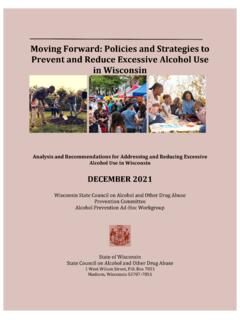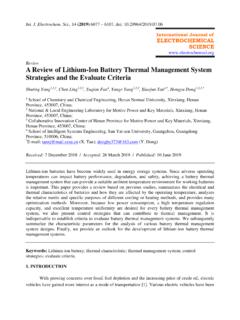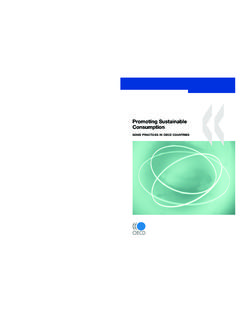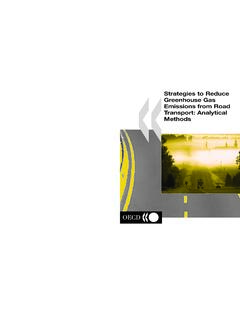Transcription of POST-HARVEST LOSSES AND STRATEGIES TO REDUCE THEM
1 Technical paper Scientific & Technical Department POST-HARVEST LOSSES AND STRATEGIES TO. REDUCE THEM. By Victor Kiaya ACF January 2014. LEGAL INFORMATION. Statement on Copyright Action Contre la Faim (ACF), member of ACF International. Unless otherwise specified, reproduction is permitted, as long as the source is credited. If reproduction or use of textual and multimedia data (sound, images, software, etc.) are submitted for prior authorization, such authorization will cancel the general authorization described above and will clearly indicate any restrictions on use. Non responsibility clause This document provides public access to information concerning the actions and policies of ACF International. Our objective is to disseminate information that is accurate and up-to date on the day it was initiated. We will make every effort to correct any errors that are brought to our attention. However, ACF bears no responsibility for information contained in this document.
2 This information: Is solely intended as general information and does not focus on the particular situation of any physical person, or person holding any specific moral opinion;. Is not necessary complete, exhaustive, exact or up-to-date;. Sometimes refers to external documents or sites over which ACF has no control and for which ACF declines all responsibility;. Does not constitute legal advice. The present non-responsibility clause is not aimed at limiting ACF s responsibility contrary to requirements of applicable national legislation, or at denying responsibility in cases where this cannot be done in view of the same legislation. Technical paper on POST-HARVEST LOSSES ACF-January 2014 Page 2. Introduction Today, one of the main global challenges is how to ensure food security for a world growing population whilst ensuring long-term sustainable development. According to the FAO, food production will need to grow by 70% to feed world population which will reach 9 billion by Further trends like increasing urban population, shift of lifestyle and diet patterns of the rising middle class in emerging economies along with climate change put considerable pressure strain on the planet s resources: declining freshwater resources and biodiversity, loss of fertile land, etc.
3 Consequently, there is a need for an integrated and innovative approach to the global effort of ensuring sustainable food production and consumption (Nellemann et al., 2009; World Economic Forum 2009; FAO/OECD, 2011; Foresight, 2011; EU ERA-NET. SUSFOOD 2012-2014). In the meantime, while the number of food insecure population remains unacceptably high (FAO, 2010; IFAD, WFP and FAO, 2012), each year and worldwide, massive quantities of food are lost due to spoilage and infestations on the journey to consumers (FAO, 2011;. Stuart, 2009; FAO, 2002). In some African, Caribbean and Pacific ACP countries, where tropical weather and poorly developed infrastructure contribute to the problem, wastage can regularly be as high as 40-50% (SPORE, 2011). Obviously, one of the major ways of strengthening food security is by reducing these LOSSES . Along the renewed focus on investment in agriculture that began in 2008, there is an increasing interest in effective intervention for POST-HARVEST LOSSES (PHL) reduction.
4 The investment required to REDUCE PHL is relatively modest and the return on that investment rises rapidly as the price of the commodity increases. Action Contre la Faim (ACF) gives a particular attention to PHL reduction. During a research prioritization exercise undertaken by ACF Food Security and Livelihoods sector (FSL) in 2011, postharvest handling was recognized as one of the important areas requiring attention. It is of high importance in the effort to combat hunger, raise income and improve food security and livelihoods in the areas where ACF intervenes. In view of this, it was decided to develop a brief technical paper on postharvest LOSSES and strategy to REDUCE them. The term postharvest loss - PHL refers to measurable quantitative and qualitative food loss in the postharvest system (de Lucia and Assennato, 1994). This system comprises interconnected activities from the time of harvest through crop processing, marketing and food preparation, to the final decision by the consumer to eat or discard the food.
5 Nowadays, interventions in PHL reduction are seen as an important component of the efforts of many agencies to REDUCE food insecurity. PHL is increasingly recognized as part of an integrated approach to realizing agriculture s full potential to meet the world s increasing food and energy needs. Therefore, reducing PHL along with making more effective uses of today s crops, improving productivity on existing farmland, and sustainably bringing additional acreage into production is critical to facing the challenge of feeding and increased world population. It is, however, evident for ACF that postharvest and value addition are integral components of STRATEGIES to improve agricultural productivity and linkages between farmers and markets Technical paper on POST-HARVEST LOSSES ACF-January 2014 Page 3. which will help contribute to food security and economic development of its target population. This technical paper highlights some concepts and problems of postharvest food LOSSES in cereals and perishable crops, and critical factors governing PHL and food waste.
6 It covers LOSSES occurring along the entire food chain, and highlights some STRATEGIES and alternatives ways of preventing and reducing these LOSSES . The paper has a special focus on less developed countries where ACF missions intervene. 1. Few definitions and concepts What is postharvest loss? Postharvest loss can be defined as the degradation in both quantity and quality of a food production from harvest to consumption . Quality LOSSES include those that affect the nutrient/caloric composition, the acceptability, and the edibility of a given product. These LOSSES are generally more common in developed countries (Kader, 2002). Quantity LOSSES refer to those that result in the loss of the amount of a product. Loss of quantity is more common in developing countries (Kitinoja and Gorny, 2010). A recent FAO report indicates that at global level, volumes of lost and wasted food in high income regions are higher in downstream phases of the food chain, but just the opposite in low-income regions where more food is lost and wasted in upstream phases (FAO, 2013).
7 Why ACF is concerned about PHL? Farmers and food sellers have been concerned about LOSSES since agriculture began. Yet the problem of how much food is lost after harvest to processing, spoilage, insects and rodents, or to other factors takes on greater importance as world food demand grows. Cutting postharvest LOSSES could, presumably, add a sizable quantity to the global food supply, thus reducing the need to intensify production in the future. Agricultural crops LOSSES LOSSES are a measurable reduction in foodstuffs and may affect either quantity or quality (Tyler and Gilman, 1979). They arise from the fact that freshly harvested agricultural produce is a living thing that breathes and undergoes changes during postharvest handling. Loss should not be confused with damage, which is the visible sign of deterioration, for example, chewed grain and can only be partial. Damage restricts the use of a product, whereas loss makes its use impossible.
8 LOSSES of quantity (weight or volume) and quality (altered physical condition or characteristics) can occur at any stage in the postharvest chain (Fig 1). Technical paper on POST-HARVEST LOSSES ACF-January 2014 Page 4. Weight LOSSES in traditional postharvest chain Cutting Manual Sun Open Village Small handling threshing drying storage milling retailer 1-5% 1-5% 3-5% 5-10% 20-30%. Crop Quality loss resulting in 10 30% loss in value consumption Weight LOSSES in mechanized postharvest chain Combine Machine Mechanical Sealed Commercial Large harvesting threshing drying storage milling retailers 1-5% 1-5% 1-2% 1-2% 5-30%. Fig. 1. Estimated LOSSES (weight and quality) from the postharvest chain for rice in south Asia (After Hodges et al. 2011). Economic loss can also occur if the produce is subsequently restricted to a lower value market. Here, food loss is a subset of PHL and represents the part of the edible share of food that is available for consumption at either the retail or consumer levels but not consumed for any reason.
9 Food LOSSES and Food Waste Food LOSSES refer to the decrease in edible food mass (dry matter) or nutritional value (quality) of food that was originally intended for human consumption (FAO, 2013). Food LOSSES take place at production, postharvest and processing stages in the food supply chain (Parfitt et al., 2010). Food LOSSES are mainly due to poor infrastructure and logistics, lack of technology, insufficient skills, knowledge and management capacity of supply chain actors, and lack to markets. Food waste refers to food appropriate for human consumption being discarded, whether or not after it is kept beyond its expiry date or left to spoil. Food waste occurs at the food chain (retail and final consumption ) and relates to retailers and consumers behaviour. Food wastage refers to any food lost by deterioration or waste. The term wastage includes both food loss and food waste Food waste or loss is measured only for products that are directed to human consumption , excluding feed and parts of products which are not edible.
10 As defined by Hodges et al. (2011), food waste is the subset of food loss that is potentially recoverable for human consumption . Therefore, food that was originally meant to human consumption but which fortuity gets out the human food chain is considered as food loss or waste even it is then directed to a non-food use (feed, bioenergy, etc.). This approach distinguishes planned non-food uses and unplanned non-food uses, which are hereby accounted under LOSSES (FAO, 2011). Technical paper on POST-HARVEST LOSSES ACF-January 2014 Page 5. Table 1: Generic food supply chain and examples of food waste (Parfitt et al., 2010). Stage Examples of waste 1. Harvesting, handling at harvesting Edible crops left in field, ploughed into soil, eaten by pests; timing of harvest not optimal;. crop damaged during harvesting 2. Threshing Loss due to poor technique 3. Drying, transport and distribution Quality and quantity loss of during drying, poor transport infrastructure; loss owning to spoiling/bruising 4.





